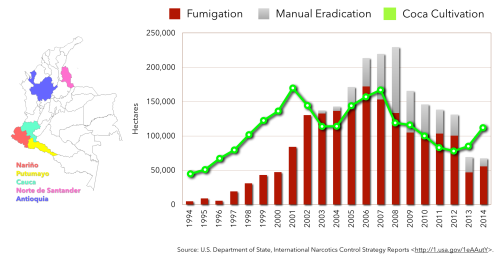Coca Cultivation Up in Colombia
Adam Isacson notes that coca cultivation in Colombia is up. I'm taking his graph:
The key point he makes is one I talk about in my Latin American Politics class--the absence of the state.
[T]he presence of Colombia’s state has not improved in coca-growing zones, as Colombia has put fewer resources into the “National Consolidation Plan” and similar efforts to bring government services into neglected areas. The “stick” has declined, but so has the “carrot.”
A similar dynamic plays out in southwestern Colombia, where the government has ended aerial spraying but hasn't developed new programs.
Eradication has also been limited in zones, like the Catatumbo region in Norte de Santander, where the government has been negotiating with organized farmer protests. While the government has abstained from aerial spraying in these zones, however, there is little evidence to indicate that it has replaced spraying with other methods, such as voluntary eradication agreements or manual eradication.
Reducing coca cultivation is not just about ending dangerous eradication practices like aerial spraying (though I should mention that it's a welcome development). It's about moving the Colombia state into areas that have been been historically ignored. That means not just crop substitution but infrastructure.
It also means dealing with the massive displaced population. As it turns out, places like Norte de Santander are precisely also where there is a lot of continued conflict. Unfortunately, that's an angle you don't normally hear about, especially from policy makers.
Update: And I wonder what the effects will be from the Colombians returning home because Venezuela's economy is crashing?


0 comments:
Post a Comment